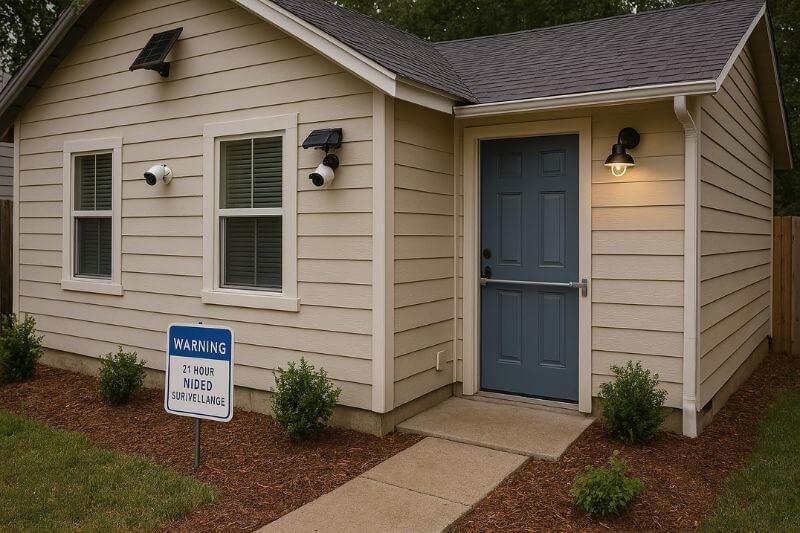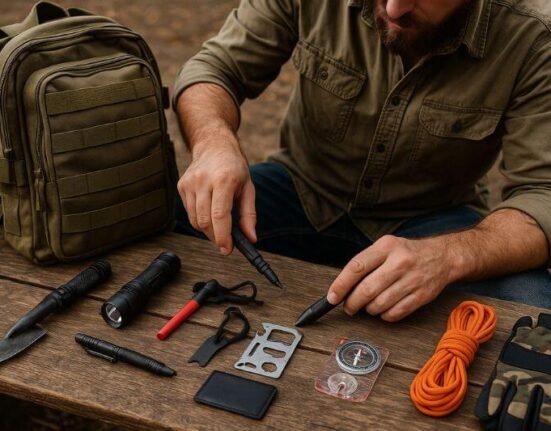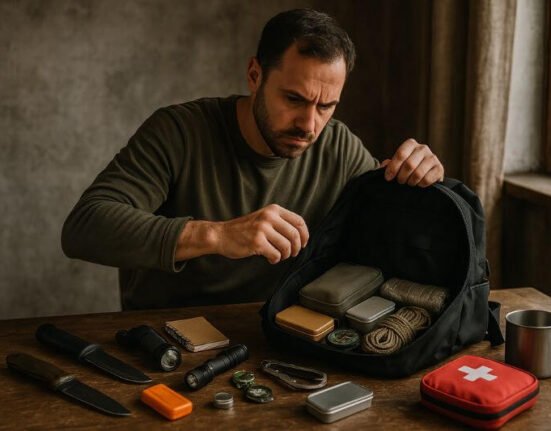DIY home security is no longer a niche concept—it’s a necessity for millions of people looking to stay safe in an increasingly unstable world. Whether you’re on a tight budget, living off-grid, or simply don’t trust third-party installers, building your own defense system is not only possible in 2025—it’s smarter than ever.
In this guide, we’ll break down the most effective and affordable ways to secure your home using tools, skills, and strategies you can implement yourself—no technician required.
🧠 PART 1: WHY DIY HOME SECURITY MAKES SENSE IN 2025
1. The New Era of Self-Reliance
We live in an age of uncertainty. Grid failures, rising burglary rates, slower emergency response times, and distrust in big tech have driven more people to take their home security into their own hands.
According to a 2024 study by the National Crime Prevention Council, 42% of homeowners under 40 now prefer DIY home security over professional installations.
Why?
- Lower cost and no contracts
- Full control over system features and data
- Flexibility to adapt and expand over time
- Reduced reliance on vulnerable infrastructure (Wi-Fi, monitoring centers)
“A decentralized approach to security is a logical response to a decentralized world.”
— CivilFall Resilience Report, 2024
2. The Core Principles of DIY Home Security
Before you start shopping for cameras or sensors, you need to understand the foundations of DIY home protection. It’s not about buying gadgets—it’s about building layers of deterrence and detection.
🧱 The 4 Security Layers You Can Build Yourself:
- Deter – Make your home an unappealing target
- Detect – Know when someone crosses the line
- Delay – Slow down or prevent entry
- Defend – Be ready to respond if necessary
You don’t need to be a tech expert or a contractor. What you need is:
- A bit of time
- A modest budget
- A clear plan
📌 The best DIY systems start with awareness: walk around your property like a burglar. What would you exploit?
3. Budget Breakdown: DIY vs Professional
Let’s compare the financial side. What do you really save by going the DIY route?
| Setup Type | Upfront Cost | Monthly Fees | Flexibility | Installation Time |
|---|---|---|---|---|
| DIY Basic Setup | $150–$400 | $0–$10 | High (modular, portable) | 1–3 hours |
| Professional System | $0–$250+ | $30–$70 | Low (locked contracts) | Technician scheduled |
🔧 With DIY, you own everything. No service interruptions. No unexpected fees.
💡 Example: Using an $80 Wi-Fi camera, $30 motion sensor, and $25 smart plug, you can build a basic alert system in under two hours—fully controlled via your phone.
🛠️ PART 2: ROOM-BY-ROOM DIY SECURITY SOLUTIONS
4. Fortify Your Entry Points — Doors, Locks & Cameras
Your front door is your first line of defense—and the most common entry point for intruders. A proper DIY home security setup always starts there.
🚪 Essentials for Door Security:
- Reinforced strike plate with 3” screws into wall studs
- Door security bar or brace (ex: Nightlock)
- Smart deadbolt with keypad or fingerprint sensor
- Video doorbell camera with night vision & 2-way audio
- Fake or real security signs near the entry
📌 Pro Tip: Mount your video doorbell at shoulder height, angled downward, to avoid blind spots.
🚪 Secondary Entry Protection:
- Back door: replicate front door setup
- Garage door: add slide bolt or smart plug to disable remote opening
- Side gates: lockable latches, motion-activated floodlights
5. Secure Your Windows & Sliding Doors
Windows are silent vulnerabilities—easy to break, hard to monitor without the right tools.
🪟 DIY Solutions That Work:
- Security film: Resists shattering from blunt force
- Window locks: Especially for sliding types
- Glass break sensors: Trigger alarms if a window is smashed
- Window vibration alarms: Cost ~$10 each, simple to install
- Motion-activated exterior lights: Covers approach areas
🔧 If you’re on a tight budget, reinforce ground-floor windows and those hidden from street view first.
6. Don’t Forget the Backyard & Perimeter
Most homeowners secure the front but forget the back. Don’t make that mistake.
🌳 Outdoor DIY Security Must-Haves:
- Motion-sensing floodlights: Solar-powered if possible
- Dummy cameras + 1 real one in a strategic location
- Yard signs (“24/7 surveillance,” “guard dog,” etc.)
- Sensor tripwire alarms or magnetic driveway sensors
- Noise makers: Wind chimes, gravel, or tactical deterrents
| Location | Recommended Tool | Cost Estimate |
|---|---|---|
| Backyard gate | Smart padlock or manual chain | $25–$60 |
| Driveway | Motion sensor or trip alarm | $30–$100 |
| Hidden windows | Security film + light | $40–$80 |
“DIY perimeter defense is about delay and detection—not confrontation. Make intruders rethink before they ever step inside.”
— CivilFall Tactical Manual, 2025 Edition
7. Inside the House: Smart Layers & Panic Zones
Once a perimeter is breached, your system should give you time and awareness, not just alerts.
🛏️ Interior Setup Suggestions:
- Motion sensors in halls, stairs, and large rooms
- Smart lights triggered by movement or remote control
- “Safe room” with manual lock, flashlight, first aid, phone charger
- Personal alarm buttons for bedrooms or elderly family
- Indoor cameras pointed at entry chokepoints (not living areas for privacy)
📌 Keep security discreet—but accessible. Label drawers with pepper spray, backup keys, or tools for emergency use.
🤖 PART 3: AUTOMATION, BUDGET SETUPS & FINAL STRATEGY
8. Automate Your Defense with DIY Smart Tech
In 2025, DIY home security is smarter and more accessible than ever. With just a few affordable devices, you can automate your defense—even without a central hub.
🔌 Smart Automation Tools:
- Smart plugs: Control lights or sound decoys remotely
- IFTTT or Alexa Routines: Link motion sensors to lights/cameras
- Smart locks: Auto-lock doors at night or after closing
- Wi-Fi alarm sirens: Trigger on contact sensor or motion
- Door sensors + smart bulbs: Flash lights when a breach is detected
💡 Example: Using a $25 sensor and a $15 smart bulb, you can flash red lights when someone opens your back door at night—without monthly fees or contracts.
9. DIY Home Security by Budget
You don’t need thousands to stay safe. Here’s how to build layered security at different budget levels:
🪙 Entry-Level Setup (< $200)
- 2 door/window sensors
- 1 Wi-Fi camera (indoor)
- Motion light for back door
- Basic smart plug for automation
✅ Best for: Renters, students, small apartments
💵 Mid-Range Setup ($300–$600)
- 4–6 sensors (doors + windows)
- Video doorbell or outdoor cam
- Smart lock + floodlight
- Local alarm siren
✅ Best for: Townhouses, suburban homes
💰 Full Setup ($800+)
- 8+ sensors
- Indoor + outdoor cameras
- Smart lights and locks
- LTE or solar backup
- Driveway or perimeter detection
✅ Best for: Remote homes, off-grid cabins, families
10. Final Checklist Before You Call It Secure
Before you call your DIY system complete, review this essential checklist:
✅ DIY Home Security Final Checklist
- 🔲 All main doors and windows covered with sensors
- 🔲 Outdoor lights and cameras visible from approach angles
- 🔲 Motion alerts tested and reliable
- 🔲 Backup power or low-battery notifications set up
- 🔲 No false alarms triggered by pets/kids
- 🔲 System tested at night and in daylight
- 🔲 Phone alerts or app access confirmed
“If you haven’t tested it under pressure, it doesn’t work. Your DIY home security is only as good as your last dry run.”
— Urban Resilience Tactics, 2025
🧩 CONCLUSION: DIY ISN’T CHEAP—IT’S SMART
DIY home security in 2025 isn’t about cutting corners—it’s about building resilience on your terms. When you control your setup, you control your privacy, your budget, and your safety.
Whether you spend $150 or $1,000, a smart, well-thought-out system will always outperform a flashy, overpriced package that doesn’t suit your real risks.
🎯 Next Step: Walk your perimeter, list your vulnerabilities, and build your DIY security plan layer by layer. You don’t need permission—you just need action.
❓ FAQ – DIY Home Security in 2025
Q: Can I build a DIY home security system with no technical skills?
A: Absolutely. Most modern DIY home security systems are designed to be user-friendly and plug-and-play. If you’re comfortable installing a smart bulb or pairing a device to your phone, you can build your own system.
Brands like SimpliSafe, Ring, and Abode offer:
- Pre-configured starter kits
- Step-by-step mobile apps
- Self-diagnosing sensors and devices
- Modular setups that can grow with your needs
💡 Tip: Start small—secure doors and windows first, then expand to cameras, lights, and smart locks as needed.
Q: Do I need Wi-Fi for a DIY system?
A: Not necessarily. While Wi-Fi enables real-time alerts and smart automations, many systems offer alternatives:
- Cellular backups for emergency communication
- Local storage (SD card or NAS) for video footage
- Bluetooth or Zigbee/Z-Wave communication between devices
However, Wi-Fi remains the best choice for:
- Remote monitoring via smartphone
- Voice assistant integration (e.g. Alexa, Google)
- Cloud storage and software updates
📌 Make sure your system has a backup communication method in case your internet goes down during a power outage or cyber event.
Q: What’s the biggest mistake in DIY home security?
A: The most common (and costly) mistake is incomplete coverage.
Many DIY users forget to:
- Secure back doors and basement entries
- Cover garage windows or side gates
- Install motion sensors in blind spots
- Test their system at night or under stress
“Your system is only as strong as its weakest, most forgotten entry point.”
— CivilFall DIY Prep Guide, 2025
💡 Solution: Do a full walk-around of your home at night, and create a simple checklist of vulnerabilities.
Q: Are DIY systems legal everywhere?
A: In most U.S. states and many countries, DIY systems are fully legal, especially those used inside your own property.
However, you should be aware of:
- Surveillance laws: Avoid pointing outdoor cameras directly at neighbors’ windows or private areas
- Audio recording restrictions: Some regions require consent for audio monitoring
- Wireless frequency regulations: If importing sensors, check they’re compliant with local radio standards
📚 Always consult your city or state’s privacy laws, and review any applicable HOA or rental agreements before installing visible devices.















